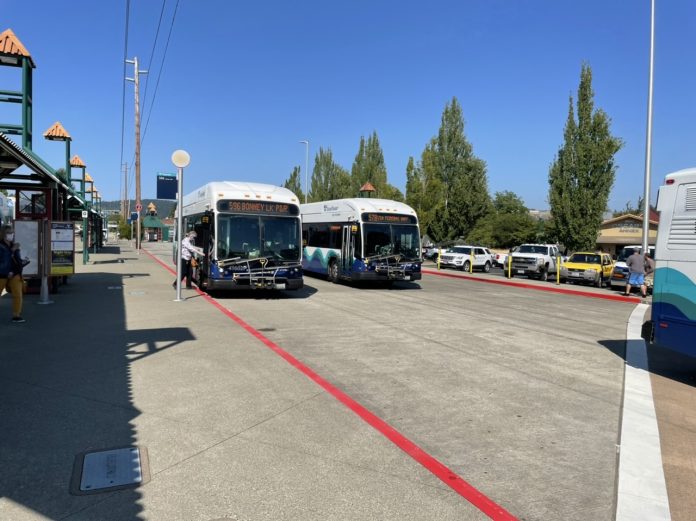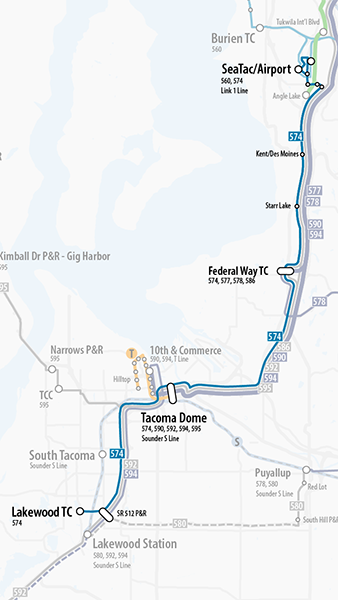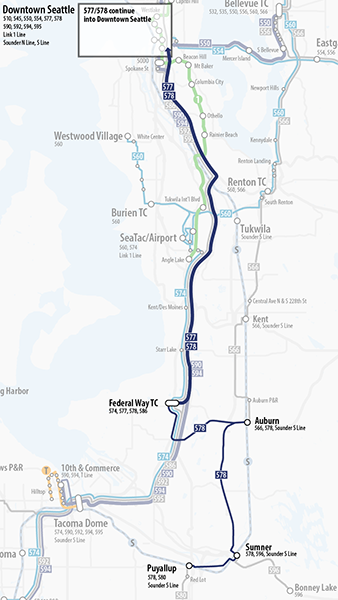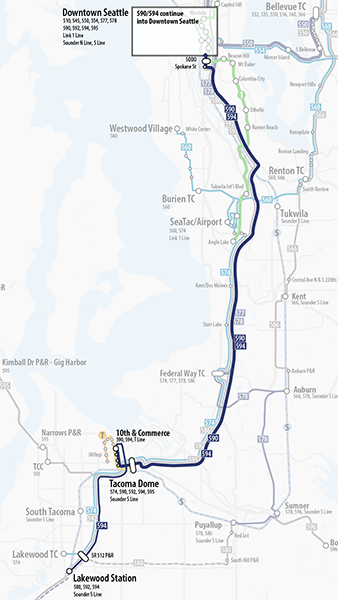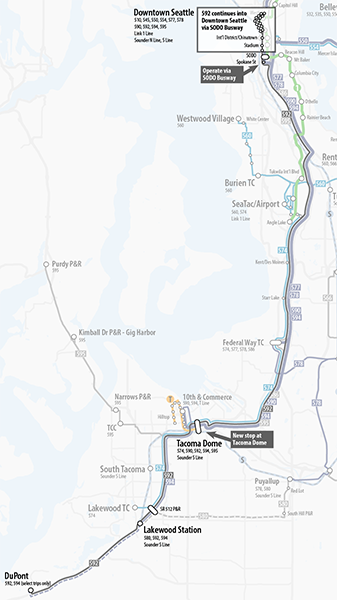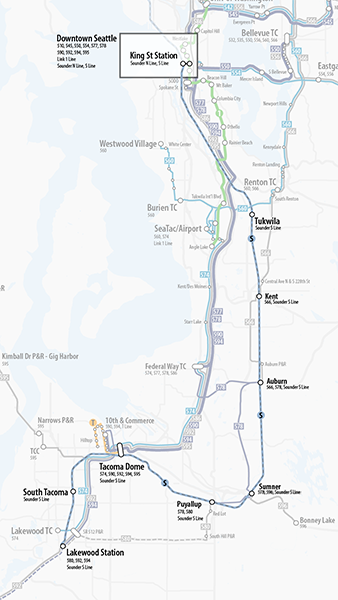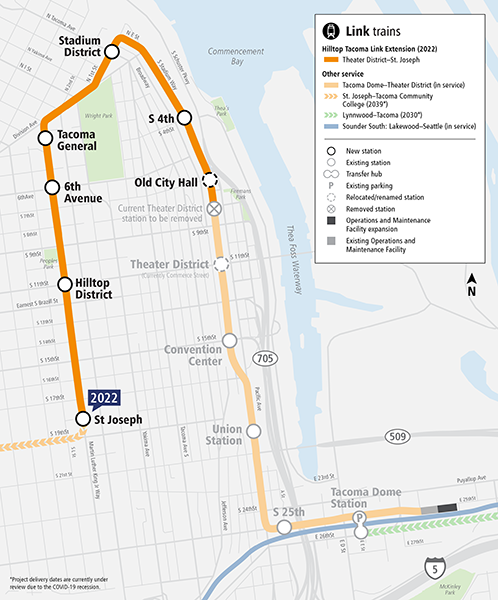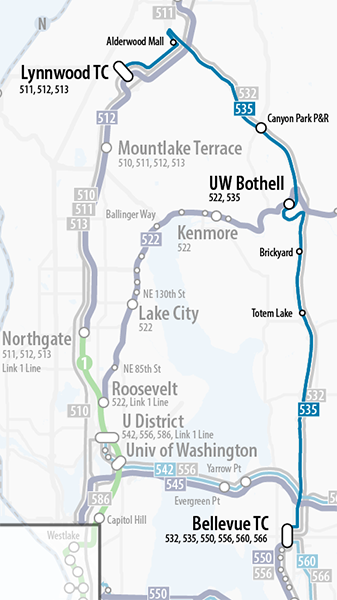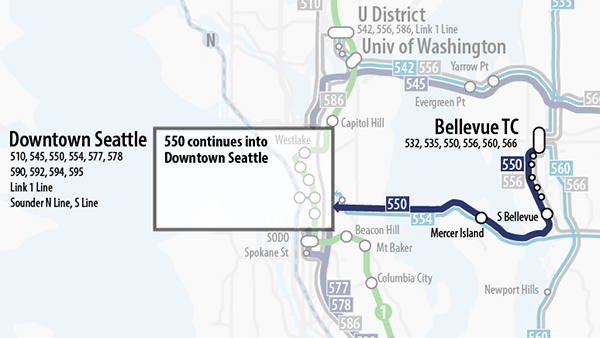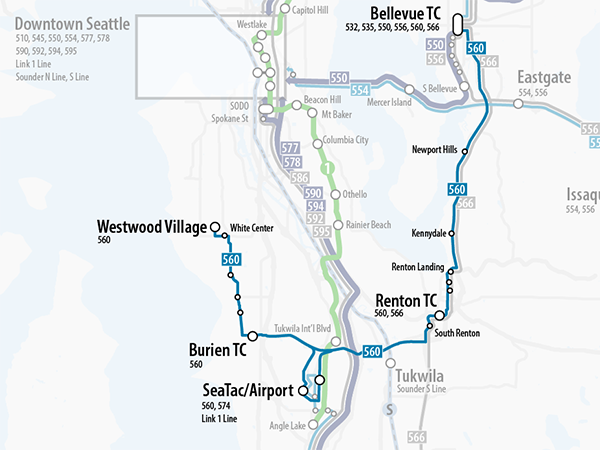ST Express bus service is a big focus for improvement in Sound Transit’s 2022 service proposal. Next year, all-day frequencies are poised to improve across many routes to provide more consistency across time of day and on weekends. Sound Transit is also proposing improved frequencies on the Tacoma T Line and restoration of trips on the Sounder S Line next year. However, the Link 1 Line and Sounder N Line are seemingly left out in the proposals for added service.
Along with the proposed 2022 service plan, Sound Transit has a handy new system map that differentiates between modes and highlights service quality of ST Express routes. Link light rail/streetcar and Sounder commuter rail lines are denoted with their alphanumeric line letters and numbers and colors. ST Express bus services are also denoted by their route numbers and further emphasized with colors by the type of service provided (limited, peak-hour, and all-day). Frequent routes and combined routes are also highlighted to give a sense of just how much service is offered.
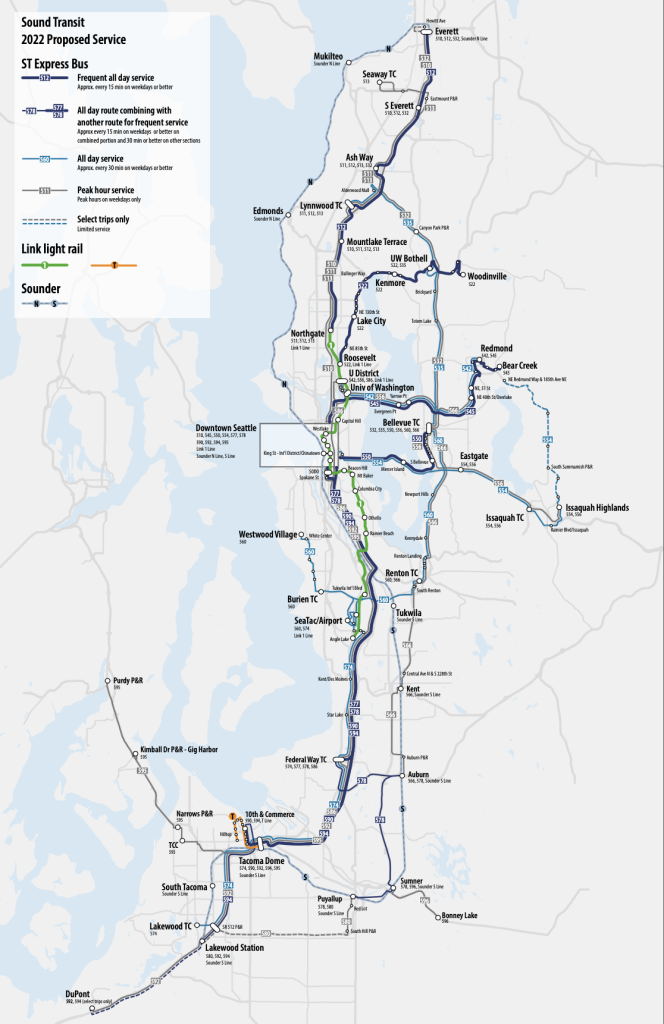
Service improvements for Tacoma and Federal Way are a high priority in the proposal since ridership has remained particularly strong during the pandemic and it achieves equity goals. As we reported earlier this month, “Data from March showed that South ST Express had 35% of pre-pandemic weekday ridership levels compared to 23% for Link, 22% for North ST Express, 16% for East ST Express, 14% for South Sounder, and 4% for North Sounder.” That kind of strength has convinced Sound Transit that additional investments in the South ST Express corridor is a worthy objective. Additional service could also help build ridership in anticipation of the Federal Way Link extension opening in 2024 and the Tacoma Dome Link extension possibly opening in 2032.
The proposed South ST Express service changes shake out as follows:
- Route 574 (Lakewood-SeaTac) would benefit from a wider span of service starting earlier and ending later so that airport workers have more choices to commute via transit. All other service levels would remain the same.
- Route 577 (Federal Way-Seattle) would benefit from increased frequencies during weekday middays and during weekend days. This would improve those frequencies from every 30 minutes to every 15 minutes. When combined with Route 578, this gives riders 15-minute or better service from Federal Way to Seattle all day, except early morning and late evenings, seven days a week.
- Route 578 (Puyallup-Seattle) would benefit from additional frequency on weekends during the day, improving from every hour to every 30 minutes.
- Routes 590/594 (Tacoma-Seattle/Lakewood-Seattle) would provide a combined benefit from increased frequencies during weekday middays and weekend days, improving from every 30 minutes to every 15 minutes from Tacoma. This gives riders 15-minute or better service from Tacoma to Seattle all day, except evenings, seven days a week.
- Route 592 (DuPont-Seattle) would benefit from a new stop at Tacoma Dome. This would allow for other local and regional transit connections in Tacoma that the route doesn’t offer today. The route would also be adjusted in Seattle to operate on the SoDo Busway with new stops, including at Stadium Station and International District/Chinatown Station.
Additionally, Sound Transit is planning other service improvements that benefit Pierce County and South King County riders with the following changes:
- T Line (Tacoma Link Streetcar) is expected to open with an extension in May next year from Downtown Tacoma to the Tacoma Hilltop neighborhood. Frequency on the line is proposed to improve from every 12 minutes to every 10 minutes.
- S Line (Tacoma/Lakewood-Seattle Sounder) would benefit from its full slate of pre-pandemic trips being restored by September 2022. Nine trips currently operate with two additional ones planned for restoration this September (Train 1507 at 2:35pm from Seattle to Tacoma and Train 1520 from 4:06pm from Tacoma to Seattle). This would mean two more trips return next year for the full daily weekday 13 trips.
Sound Transit proposes a handful of other ST Express bus service enhancements:
- Route 535 (Lynnwood-Bellevue) would benefit from new Sunday service and increased Saturday frequencies. Sunday service would be every 30 minutes during the day and hourly in the late evening. On Saturdays, frequency during the day would improve from hourly to every 30 minutes. This would give a fairly consistent schedule across the week. Lynnwood is a booming center and poised to get an I-405 running bus rapid transit line this decade, so this service improvement is highly justified.
- Route 550 (Seattle-Bellevue) would benefit from increased Sunday service with 15-minute frequencies throughout the day. This would be accomplished by reallocating some weekday morning peak-hour trips and possibly others. In 2023, the East Link line will open and replace this route, making enhanced Sunday service a good move to encourage everyday ridership ahead of the change.
- Route 560 (West Seattle-SeaTac-Bellevue) would benefit from increased weekend day frequencies, improving from every hour to every 30 minutes. Like Route 535, much of this route will eventually become a bus rapid transit service this decade, so higher frequencies here make sense ahead of that change.
However, the proposed service changes would not further alter service on the Link 1 Line and Sounder N Line (Everett-Seattle). Both choices are odd for different reasons.
This fall, Sound Transit will extend the 1 Line to Northgate Station, adding three stops in dense neighborhoods like the University District and Roosevelt. Along with this, the bus network will be altered to push riders to make transfers with Link, particularly at Northgate Station where many commuter express buses will be fed. Ridership on Link has bounced back, especially during midday periods and is likely to continue further improving as the pandemic resides, and Downtown and University District workers are poised to head back to work in large numbers. Keeping frequencies at every eight minutes during weekday peak hours, every ten minutes during weekday off-peak hours and on weekends, and every 15 minutes during late evening hours seems ill-fated. Light rail frequencies should be higher across all time periods.
As far as the N Line goes, Sound Transit is only offering two daily weekday trips. While ridership is indeed low because of the pandemic, running trips as such almost non-existent frequencies and the curtailment of the Amtrak Cascades RailPlus program (trips aren’t running north of Seattle right now) necessarily drives ridership levels even further downward. In other words, low ridership is a self-fulling prophecy. As Jarrett Walker says, “frequency is freedom.”
Sound Transit also has said that peak hour-only routes would remain suspended into 2022. This affects services like Routes 541, 544, 555, and 567, which the agency considers redundant and essentially running along similar corridors to all-day routes.
Also not mentioned in the service proposal are further changes to Route 542 and 556. Those route is supposed to be adjusted in the fall with a cutback to U District Station instead of running all the way to Green Lake Park-and-Ride and Northgate. But future proposals would be wise to reconsider their alignment given that they’re tech-oriented routes to Redmond and Bellevue. Modifying the routes to serve Fremont and Ballard along the north side of the lakes via the University District could add a badly needed frequent connection to Eastside urban centers, skipping the need for slower local routes like Routes 31, 32, and 44. Another helpful change would be straightening out the alignment of Route 522 in Woodinville by serving the bourgeoning city center via NE 175th St.
Nevertheless, the proposed service changes will be a big improvement for riders, particularly those riders who want to move across the regional bus system any day of the week.
An online survey on the proposed 2022 service plan is open through August 22nd. A virtual public hearing will also be held at 11:00am on August 12th. Weigh in on the proposal with your feedback.
Stephen is a professional urban planner in Puget Sound with a passion for sustainable, livable, and diverse cities. He is especially interested in how policies, regulations, and programs can promote positive outcomes for communities. With stints in great cities like Bellingham and Cork, Stephen currently lives in Seattle. He primarily covers land use and transportation issues and has been with The Urbanist since 2014.


